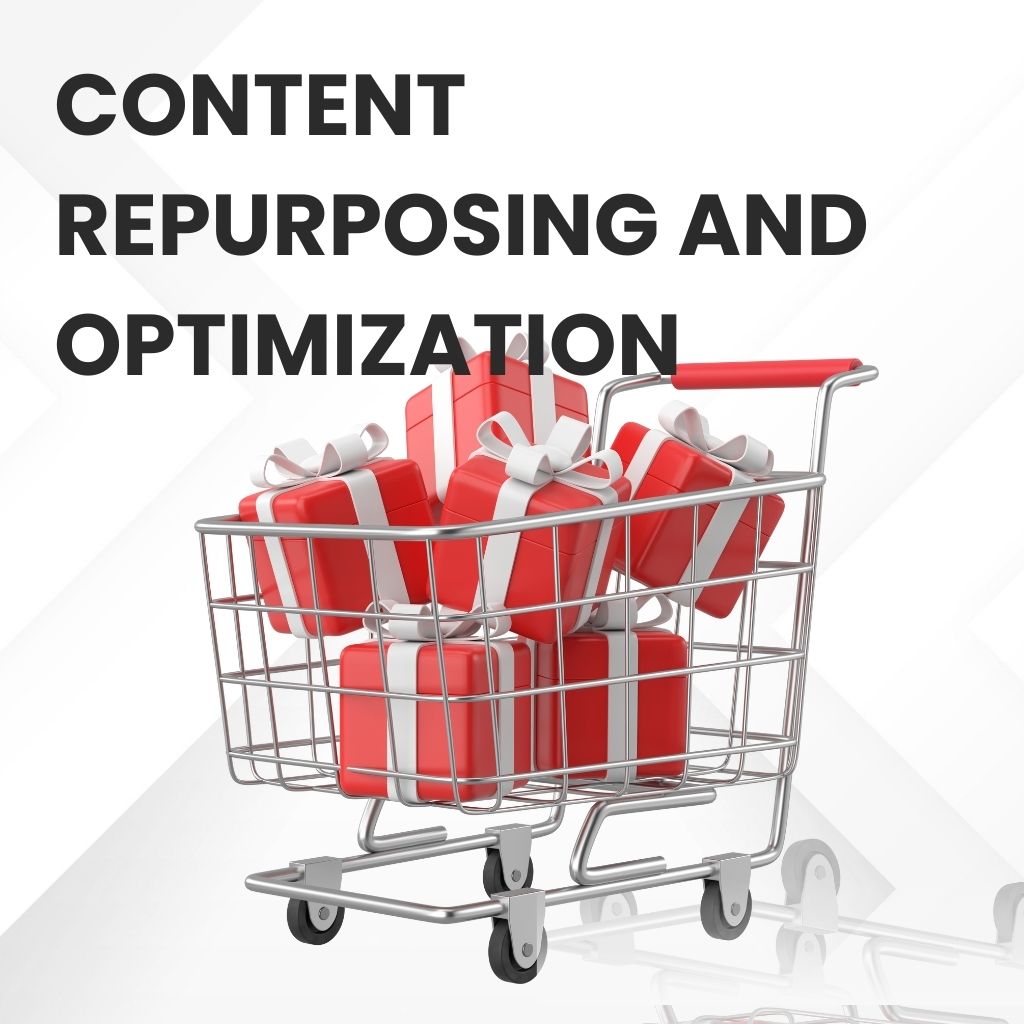
Article: Repurposing & Optimization: How to Maximize Content Value, Reach Wider Audiences, and Drive Long-Term Growth
In the digital era, content is king — but creating high-quality content consistently takes time, effort, and resources. Too often, businesses produce a blog post, share it once, and move on to the next piece. This approach leaves massive untapped potential on the table. The reality is that your existing content is a goldmine, and with the right strategy, you can repurpose and optimize it to extend its lifespan, expand its reach, and multiply its impact.
This strategy is known as repurposing and optimization — and it is one of the most effective ways to maximize your content investment while ensuring long-term growth.
What is Repurposing & Optimization?
-
Repurposing content means taking existing content and transforming it into different formats to reach new audiences and platforms. For example, turning a blog post into a podcast episode, an infographic, or a YouTube video.
-
Optimization means refining and improving your content so that it ranks better, performs better, and continues to deliver results long after it was first published.
Together, repurposing and optimization ensure your content doesn’t just survive for a day — it thrives for months or even years.
Why Repurposing & Optimization is Essential
-
Maximize ROI
Content creation is resource-intensive. Repurposing allows you to extract more value from the work you’ve already done. -
Reach Wider Audiences
Different people prefer different formats — some like blogs, others prefer podcasts, videos, or social media. Repurposing meets your audience where they are. -
Boost SEO
Optimization keeps your content updated and relevant, helping you maintain or improve search engine rankings. -
Stay Consistent Without Burnout
You don’t need to create brand-new content every day. Repurposing allows you to stay consistent with less effort. -
Strengthen Authority
By covering a topic across multiple formats, you reinforce your brand’s expertise and credibility.
How to Repurpose Content Effectively
1. Turn Blog Posts into Multiple Formats
-
Create infographics highlighting the main points.
-
Record a podcast episode expanding on the article.
-
Produce a short video summarizing the tips.
-
Share bite-sized quotes and tips as social media posts.
For example, a blog titled “10 Productivity Hacks” could be repurposed into an infographic for Instagram, a YouTube video tutorial, and a podcast discussion on time management.
2. Convert Webinars into Evergreen Resources
Webinars often provide rich insights. Repurpose them into:
-
Blog posts summarizing the key takeaways.
-
Short video clips for LinkedIn and TikTok.
-
A downloadable PDF guide.
3. Transform Data into Visual Content
If you have research reports or surveys, repurpose them into:
-
Charts and infographics.
-
Slide decks for presentations.
-
LinkedIn carousels for engagement.
4. Refresh & Update Old Content
Optimization starts with reviewing existing content:
-
Update outdated statistics and links.
-
Improve readability with better formatting.
-
Add keywords to match current search intent.
-
Optimize images for faster loading.
5. Create Pillar Pages from Related Posts
Combine multiple related blog posts into a comprehensive pillar page. This strengthens SEO and gives readers a one-stop hub for knowledge.
6. Repurpose User-Generated Content
Testimonials, reviews, and customer success stories can be turned into:
-
Case study articles.
-
Social media graphics.
-
Video testimonials for websites and YouTube.
7. Cross-Promote Across Platforms
Don’t limit content to one channel. Repurpose blogs for LinkedIn articles, videos for Instagram Reels, and snippets for email newsletters.
How to Optimize Content for Maximum Performance
1. Audit Existing Content
Use tools like Google Analytics and SEMrush to see which pages are underperforming. Decide whether to update, repurpose, or merge them.
2. Improve On-Page SEO
-
Update meta titles and descriptions.
-
Use internal linking to related articles.
-
Optimize images with alt tags.
-
Ensure mobile responsiveness.
3. Enhance Readability & Engagement
-
Use shorter paragraphs and bullet points.
-
Add visuals, charts, and infographics.
-
Include clear CTAs (calls-to-action).
4. Keep Content Evergreen
Regularly update content with fresh insights, statistics, and trends so it remains relevant.
5. Analyze & Iterate
Optimization is ongoing. Track performance, test new headlines, and refine based on audience engagement.
Real-World Example of Repurposing & Optimization
Imagine a digital marketing agency publishes a blog post: “How to Improve SEO in 2025.”
They repurpose and optimize it by:
-
Turning the blog into a YouTube tutorial.
-
Extracting 5 social media posts from the main tips.
-
Creating an infographic for Pinterest.
-
Recording a podcast episode discussing SEO trends.
-
Updating the blog every six months with new statistics.
This multiplies the original blog’s value across multiple platforms, ensuring maximum reach and long-term performance.
Benefits of Repurposing & Optimization Beyond SEO
-
Brand Consistency: Keeps your message unified across platforms.
-
Audience Engagement: Different formats capture different audience preferences.
-
Saves Time & Resources: More impact with less effort.
-
Scalability: Helps small teams produce a large content footprint.
Future of Repurposing & Optimization
With AI, voice search, and short-form content rising, repurposing and optimization will only become more critical. Audiences are consuming content in diverse ways — podcasts during commutes, TikToks for quick insights, and long-form blogs for deep learning. Businesses that master content repurposing will stay visible everywhere.
Meanwhile, optimization ensures that your evergreen content remains updated and competitive in search results, even as algorithms evolve.
Conclusion
Repurposing and optimization are not shortcuts — they’re smart strategies for sustainable growth. By repurposing, you amplify your content across platforms and formats. By optimizing, you keep it relevant, visible, and effective long-term.
In a world where attention spans are shrinking but content demands are rising, businesses that master these two strategies will stand out, save resources, and achieve exponential growth.
Remember: Great content is not about creating more; it’s about making more of what you’ve already created.
Read more > https://datahome.solutions/maximize-your-contents-value-with-repurposing-optimization-by-datahome-solutions/
#RepurposingContent #ContentOptimization #DigitalMarketing #SEOContent #ContentStrategy #ContentMarketingTips #MarketingGrowth
